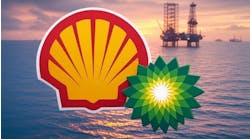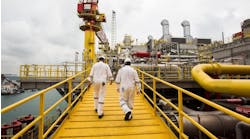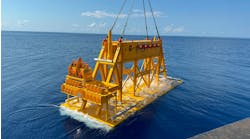William Furlow
Houston
Speculative building not the answer
Although he is the first to say we need more offshore rigs, 450 units over the next 10 years to be exact, industry analyst Matt Simmons said speculative building on the part of the service companies is not the answer. He said it would be a mistake to add new rigs without the day rates or long-term contracts to support them.As tight as the market is today, Simmons said the contractors would do well to let it get even tighter, this would force oil companies to pay higher day rates and sign the long contracts needed to justify newbuilds. If contractors cave in and begin a rash of newbuilds, the rising day rates will ebb and the cycle will begin to decline. Simmons said the best way to extend the current growth period the industry enjoys is to build only on contract.
Spin-off doctors mark end of era
After announcing late in the third quarter that its E&P subsidiary was taking an additional $16.5 million write down for yet another bad well, Reading and Bates hinted it might be time to turn its back on this losing proposition and move forward with its core business. Soon thereafter the company published its third quarter earnings with net profits way down from the same time last year, $6.4 million compared to $22.6 million.In all, Reading & Bates Development has had a total of eight unsuccessful wells since its creation in 1995. Although the company holds some unexplored prospects that could pay off for shareholders in the future, it is just about the only thing holding R&B back and is especially visible as the company enters a lucrative merger with Falcon Drilling.
This kind of equity relationship made sense when day rates were floundering, but with the current offshore boom in the Gulf of Mexico, R&B could fare better signing straight contracts. R&B CFO Tim Nagle said he would look for a spin-off of R&B Development Co. sometime next year.
We've got the leases who wants to drill?
As the dust settles from the recent Western Gulf of Mexico lease sale it is becoming clear to some analysts that many of the companies who bid on, and won, frontier properties don't have the means or wherewithal to explore or develop these prospects. Independents used to development costs in the neighborhood of $5-8 million are facing costs in the $25 million range for leaseholdings in more than 5,000 ft of water.While these companies may not be able to foot the bill, or for that matter harness the know-how to explore these properties, they can wait to see what Shell and other majors, find on their nearby deepwater properties. Which means there may be a lot of top-dollar farm-ins in the future.
Educational dividend
As service companies scramble to train new workers to man their rigs, safety has become a central issue. Transocean President Dennis Heagney said this rigorous safety training of new recruits has offered some unexpected dividends. Speaking at the recent convention of International Association of Drilling Contractors, Heagney said these new recruits often come off their first tour of duty with stories about well-seasoned workers on the rigs who did not follow the strict company safety policy. Such reporting was all but unheard of in the past, but is an integral part of the new employee outlook.Opening up the wild, wild west
Government sources close to the matter say hearings are complete on the provisional Gulf of Mexico treaty between the US and Mexico, extending out 200 miles. It is likely this treaty will be ratified by the US Senate before the end of the current term. This step would clear the way for long-awaited negotiations on the Western Gap, a diamond shaped no-man's land in the heart of the gulf.This plot of acreage with multiple claims received at least one bid in the recent Western Gulf of Mexico Lease Sale, but the bid cannot be opened until the border question is resolved. If everything goes smoothly, sources say the Gap could be negotiated in the spring of 1998.
E&P Update:
- Union Pacific Resources has an oil discovery in 3,000 ft water depths named Gomez. UPR estimates proved reserves from Gomez and probable reserves from equivalent amplitudes in adjacent blocks at 100-140 million bbl. Gomez is in Mississippi Canyon Block 755. The No. 2 well encountered 300 ft of oil pay net in three targeted horizons. UPR has 100% of 20 contiguous block. Gomez is in the center. The well was drilled to a TD of 17,707 ft.
- McMoRan Oil & Gas says its West Cameron Block 616 No. 3 well has hit 263 ft net gas pay in four sands, logged between 8,368 ft. and 9,780 ft MD. MOXY, the operator, believes that the logged pays indicate commercial quantities. Protective pipe is being set prior to drilling deeper. Anticipated TVD is 13,794.
- Houston Exploration has a successful completion in East Cameron Block 185 (No. 2). The well, drilled to a TD of 12,064 ft, encountered hydrocarbons in two sands. The company, (95% interest operator) is installing a caisson and flowline to an existing platform. Initial production was 6 MMcf/d of gas and 150 b/d.
- THX expected to place a High Island Block 138 field on production by the end of October. THX has a 100% working interest. Also, the Phoenix II rig, currently completing a workover on East Cameron Block 185, will move to drill a development well on Mustang Island Block 858.
- Basin Exploration drilled a successful exploratory well on Eugene Island Block 49 Eugene Island Block 49 (100% owned) logged an estimated 63 net ft of gas/condensate pay in multiple Miocene-aged sands below 7,300 ft TVD. The company plans to temporarily suspend the well pending completion and install minimal production facilities or connection to a nearby platform.
- Basin Exploration also reported production test results for discovery wells on Eugene Island Block 83 and West Cameron Block 56 (NE/4). The deepest productive zone in Eugene Island 83 No. 1 was tested at 15 MMcf/d and 400 boc/d, with flowing tubing pressure of approximately 3,700 psi. Shallower pay sands will remain behind the pipe for later production.
Copyright 1997 Oil & Gas Journal. All Rights Reserved.


